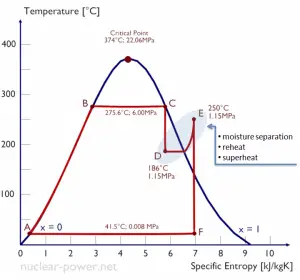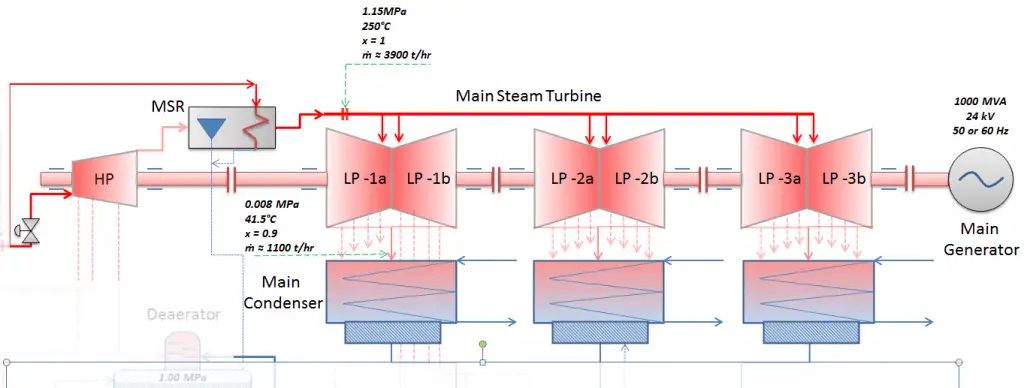Classification of Turbines – steam supply and exhaust conditions
Steam turbines may be classified into different categories depending on their purpose and working pressures. The industrial usage of a turbine influences the initial and final conditions of steam. For any steam turbine to operate, a pressure difference must exist between the steam supply and the exhaust.
This classification includes:
- Condensing Steam Turbine,
- Back-pressure Steam Turbine,
- Reheat Steam Turbine,
- Turbine with Steam Extraction
Reheat Steam Turbine

Reheat turbines are also used almost exclusively in thermal power plants. All turbines that have a high-pressure turbine and low-pressure turbines use a steam reheat between these stages. Reheat allows delivering more heat at a temperature close to the cycle’s peak (i.e., thermal efficiency increases). This requires the addition of another type of heat exchanger called a reheater. The use of the reheater involves splitting the turbine, i.e., using a multistage turbine with a reheater. It was observed that more than two reheating stages are unnecessary since the next stage increases the cycle efficiency only half as much as the preceding stage.
The turbine’s high pressure and low-pressure stages are usually on the same shaft to drive a common generator, but they have separate cases. With a reheater (moisture separator-reheater – MSR), the flow is extracted after a partial expansion (point D), run back through the heat exchanger to heat it back up to the peak temperature (point E), and then passed to the low-pressure turbine. The expansion is then completed in the low-pressure turbine from point E to point F.
The steam must be reheated or superheated to avoid damages that could be caused to the blades of the steam turbine by low-quality steam. High content of water droplets can cause rapid impingement and erosion of the blades, which occurs when condensed water is blasted onto the blades. To prevent this, condensate drains are installed in the steam piping leading to the turbine. The reheater heats the steam (point D), and then the steam is directed to the low-pressure stage of the steam turbine, where it expands (point E to F). The exhausted steam is at a pressure well below atmospheric, and, as can be seen from the picture, the steam is in a partially condensed state (point F), typically of a quality near 90%, but it is much higher vapor quality than that it would be without reheat. Accordingly, superheating also tends to alleviate the problem of low vapor quality at the turbine exhaust.
